Celebrating 20 Years of Hyde Hall
Home to the Institute for the Arts and Humanities, Hyde Hall was dedicated on University Day 2002. In recognizing its 20th year, we are launching a yearlong series exploring the Institute’s history and legacy, and the features that make Hyde Hall a special place at Carolina.
History and Legacy
Nestled in the upper quad of McCorkle Place with its brick exterior, you could be forgiven for thinking that Hyde Hall is a historic building with roots to the University’s earliest decades.
Here are highlights from the Institute’s storied history that led to the building of Hyde Hall.
Read a feature story about the milestone, titled “Hyde Hall at 20.”
Early days of the Institute

The IAH was founded in 1987 by religious studies professor Ruel W. Tyson Jr. and College of Arts and Sciences dean Gillian Cell. The provost designated West House as the program’s first home.
In 1996, the Board of Trustees approved a front campus site (McCorkle Place near Battle/Vance/Pettigrew) for a new building.
As part of the pre-construction phase, the University conducted an archaeological review of what was called the Pettigrew Site. The official groundbreaking for construction was on March 31, 2000.
View the full timeline and history of the IAH.
Dedicating Hyde Hall
After the University Day proceedings on Saturday, Oct. 12, 2002, University officials, faculty, and special guests gathered in front of the then-new Hyde Hall to officially dedicate the building.
Founding director Tyson spoke at the dedication ceremony and highlighted ‘the polity of conversation’ that the Institute encourages. We share an excerpt of his remarks below:
…The building materializes a way of thinking, and this way of thinking is already inscribed in the character of the spaces in the building. I select one, the premier space, the Fellows Room. This octagonal structure, suffused with light, opens out on all its sides, and on all but one, to the world outside. Conversely, those who pass by can sight the scene defined by the Fellows Table.
I need not expend your attention on this space since you will soon hear a reading of the Institute’s dedication day poem, by my friend, IAH Fellow, and distinguished poet and teacher, Alan Shapiro. This poem, “Conversation,” evokes the spirit, depth in time and memory, and reach in space and cultures, of the central activity of the Institute for the Arts and Humanities, the marriage of thought and talk devoted to the expression, testing, revising, and implementing of ideas. So the thinking that went into character of the building was guided by the intent of hospitality to the centrality of conversation in the work of the Institute.
The Fellows Room
Attendees at the 2002 dedication were treated to a tour of Hyde Hall, including the Fellows Room. Its design was inspired by the original Fellows Room in West House. Tyson explained the importance of that design in his dedication speech:
The tall windows of the Fellows Room remind us visually what the ethics of conversation requires of us practically:
To be vigilant in keeping the conversation open and hospitable to novel views and minority opinions.
The greatest editor of the Economist Magazine, Walter Bagehot, who had the prudence to marry the publisher’s daughter, published in 1867, a still timely book, Physics and Politics. In it Bagehot advocated “the virtue of a polity of discussion,” a summary phrase by Professor Hans Kohn, its most recent editor.
Bagehot understood the difficulty –and the discipline –of such a polity, its capacity to upset “the cake of custom,” another one of his memorable phrases.
It is meet that I remind us here today of the difficult discipline of that polity.
“One of the greatest pains to human nature,” Bagehot wrote, “is the pain of a new idea.”
The practice of a polity of conversation requires that we continue to inflict pain on human nature.
Colleagues of the faculty! Fellows of the Institute! I am speaking of us!
So this space of light will not be without its darker shadows. All will not be “sweetness and light” within, or without, if ideas take the form of action in the world.
A life of the mind without passion is sterile; passion without the discipline of other minds is vapor.
Around the table in the Fellows Room the polity of discussion will be practiced…
Installing a time capsule
 The time capsule was later installed on April 4, 2003, in the chimney of the Fellows Room, according to a letter from Tyson (that was then left in the capsule) – the cornerstone in the exterior of the building is opposite the chimney where the capsule is encased. There is a brick as part of the time capsule that hails from the “Poor House” that previously stood on the site in the 19th century.
The time capsule was later installed on April 4, 2003, in the chimney of the Fellows Room, according to a letter from Tyson (that was then left in the capsule) – the cornerstone in the exterior of the building is opposite the chimney where the capsule is encased. There is a brick as part of the time capsule that hails from the “Poor House” that previously stood on the site in the 19th century.
When opened in 2052 (50 years after the dedication ceremony), the contents of the time capsule will be given to University Archives.
Features and Spotlights
Throughout the year, we will spotlight the elements that help make Hyde Hall feel like home, from poems to artwork and more.
Below is a sampling of these features — be sure to check back through the year for more.
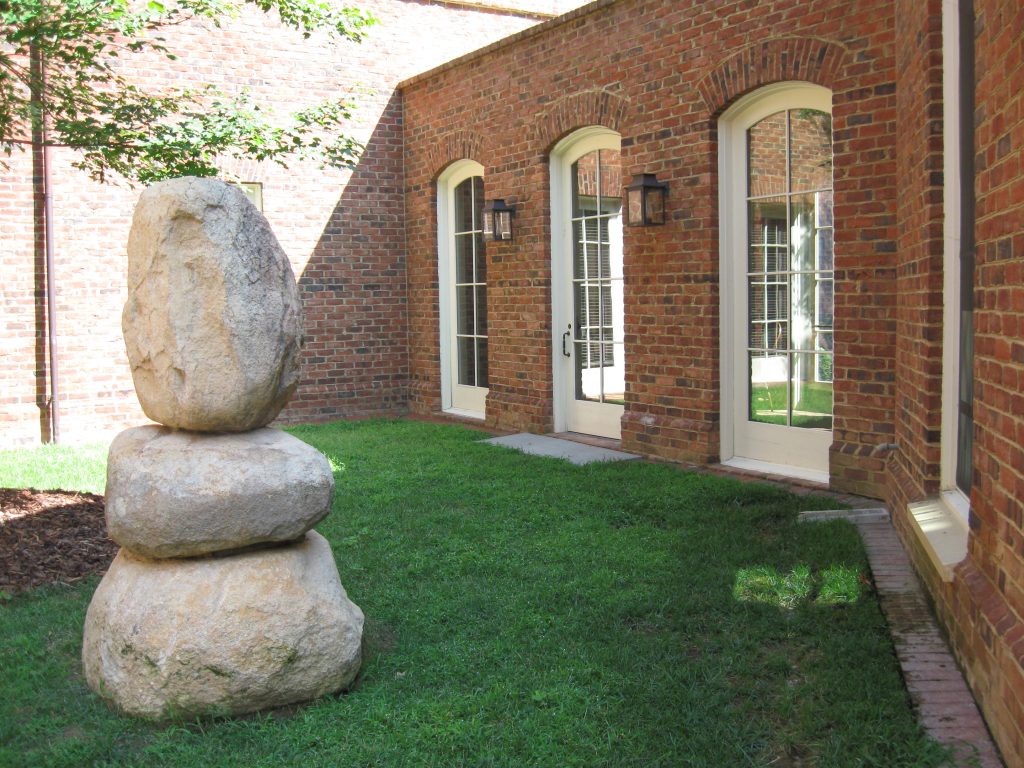
The Conversation sculpture
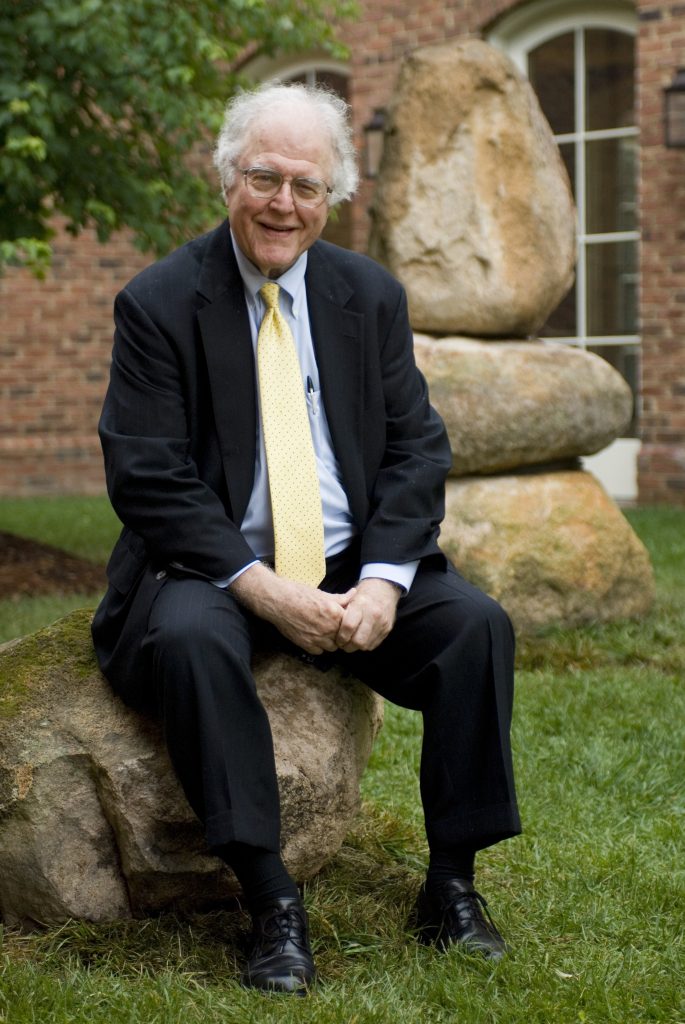
Created by sculptor Thomas Sayre, The Conversation commemorates the retirement of IAH Director Tyson in 2006. Connoisseur and collector of rocks and pebbles, Tyson created the Institute as a place where faculty engage in conversation with colleagues across disciplines. The sculpture comprises three large stones stacked on top of each other. A fourth stone near the walkway at sitting height invites passersby to pause and engage in conversation.
Sayre, of Raleigh, is a UNC-Chapel Hill graduate of English and studio art, a Public IAH Fellow and friend of Tyson.
The Winking Owl
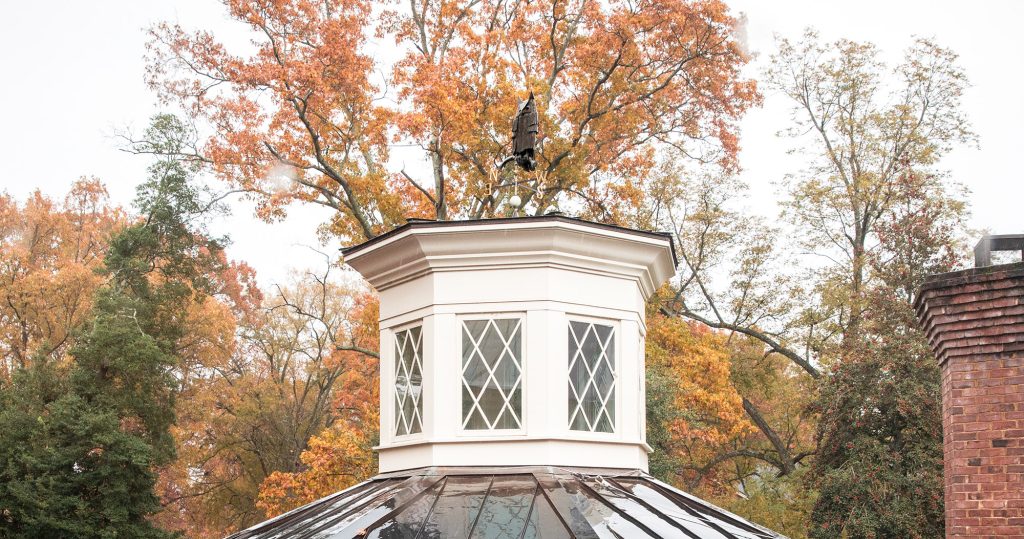
Atop the Fellows Room cupola rests a weathervane of an owl with one eye half-closed: a winking owl. Founding Director Tyson spoke on the reason of the owl’s affiliation with the Institute shortly after the opening of Hyde Hall:
The owl is not an accidental choice as an emblem for the Institute. There are three short stories regarding this owl, which inform the sculptors imagination and handwork as he created this metal object for us.
The first story is totally predictable. As many will people know, the owl was the symbol of Athena, who was the goddess of wisdom in Greek mythology and there are of course temples to Athena, prominently featuring owls.
But we have a second story and a second set of reasons for wanting to place an owl on top of Hyde Hall. We live on McCorkle Place and notoriously and famously, McCorkle Place is the home to several owls who visit us periodically and visit the squirrels as well. So we have two stories. The symbol of wisdom, an owl, and the owls who actually live on McCorkle Place.
There’s a third story, which in a sense places in question the first story about wisdom. In Chinese iconography, the owl…there’s a tradition of the winking owl and so if one had a close up look at this owl and looked at its left eye, the sculptor has tried, successfully, I think, to catch the wink in the owls left eye. The wink is intended to be ambiguous. One meaning of it in Chinese society is a social critique rather than a private confidence being shared. And then if we were genuinely in Chinese iconography, the other eye would be staring coldly but we did not want a cold, staring eye. We wanted just the delicious ambiguity of the partial wink in this owl’s left eye. We thought it was a nice judgement on the first story—the pretensions to wisdom accompanied by a real owl in between and then a wink to our pretensions to keep us humble before the extraordinary task we have of serving the faculty of the University of North Carolina and, by serving that faculty, serving the people of the state.
 This illustrated representation of the Hyde Hall owl was created by Dana Rodriguez ’17, whom the IAH had commissioned in celebration of the Institute’s 30th anniversary. As a student, Rodriguez was a psychology and art history major with a minor in Hispanic studies.
This illustrated representation of the Hyde Hall owl was created by Dana Rodriguez ’17, whom the IAH had commissioned in celebration of the Institute’s 30th anniversary. As a student, Rodriguez was a psychology and art history major with a minor in Hispanic studies.
Throughout his travels for the Next Level program, former director Mark Katz would bring back small owl figures, many of which adorn shelves throughout Hyde Hall.
The Conversation poem
All morning as we talk inside the room
around the table, our bodies are aswarm
with light and shade, our voices like a web
hung in the air between us, stitching
and unstitching in the telling and the hearing,
the taking issue with, concord and discord,
every one of us around the table
To commemorate the opening of Hyde Hall, Tyson directed writer and Fellow Alan Shapiro (FFP ’99, ’09) to craft a poem that explored the private space of the study and the public space of intellectual exchange.
The resulting poem, “The Conversation,” meditates on the open-endedness of scholarly work, which never reaches a final answer, and how conversation plays a vital role in intellectual exchange.
Read an excerpt and the story behind Shapiro’s poem.
Hyde Hall’s Kitchen
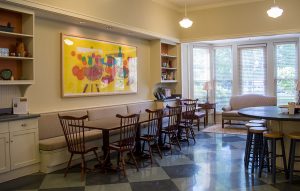 The first floor of Hyde Hall boasts a large, beautiful kitchen, given in memory of Charles E. Noell Jr. The space was designed to provide a relaxing and inviting place for faculty to gather, and to provide a practical space for caterers to prepare meals for the fellowship programs and events.
The first floor of Hyde Hall boasts a large, beautiful kitchen, given in memory of Charles E. Noell Jr. The space was designed to provide a relaxing and inviting place for faculty to gather, and to provide a practical space for caterers to prepare meals for the fellowship programs and events.
Above the banquette sits a large painting by English and Comparative Literature professor Joe Viscomi (FFP ’88, ’01). The painting, titled Representation: La Condition Magritte, alludes to the work of surrealist artist René Magritte as the fruit, wine bottle, and violin exist both in the space of the painted easel, and outside of it with the painting supplies.
In his artist statement about the painting, Viscomi describes it as “ideas coming into being. And that is what excites me the most about the Institute for the Arts and Humanities, that it is a place where ideas are born, shaped, developed, and shared.”
The 2022 Welcome Reception
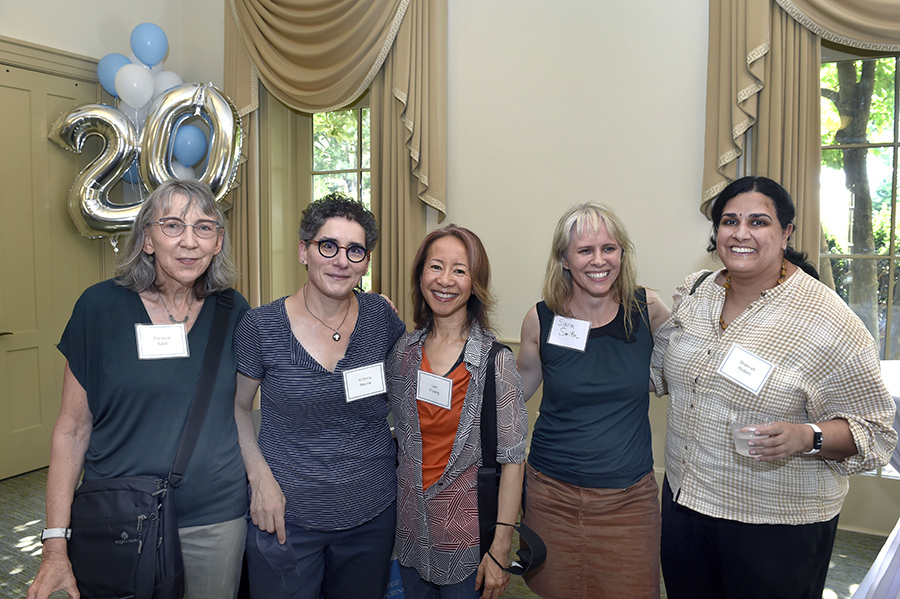
During the first week of classes, the Institute for the Arts and Humanities opened Hyde Hall to past and current Fellows, program participants, and friends for an afternoon of fellowship and food. In addition to celebrating the return of the reception and the start of the new academic year, we also recognized 20 years of Hyde Hall as the home of the IAH.
Read more about the 2022 Welcome Reception.

